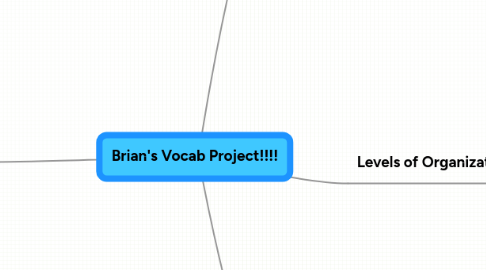
1. Population
1.1. Pioneer Species
1.1.1. A person who is among the first to explore or settle a new country or area.
1.2. Climax community
1.2.1. In ecology, a climax community, or climatic climax community, is a biological community of plants and animals which, through the process of ecological succession
1.3. Limiting factors
1.3.1. A factor or limiting resource is a factor that controls a process, such as organism growth or species population, size, or distribution. The availability of food, predation pressure, or availability of shelter
1.4. carrying capacity
1.4.1. The number or quantity of people or things that can be conveyed or held by a vehicle or container
1.5. Population growth
1.5.1. increase in the number of people who inhabit a territory or state.
1.6. Black Plague
1.6.1. the epidemic form of bubonic plague experienced during the Middle Ages when it killed nearly half the people of western Europe.
1.7. Industrial revolution
1.7.1. The rapid development of industry in Britain in the late 18th and 19th centuries, brought about by the introduction of machinery.
1.8. Exponential Growth
1.8.1. Growth whose rate becomes ever more rapid in proportion to the growing total number or size.
1.9. Sustainability
1.9.1. the property of being sustainable.
1.10. Logistic growth
1.10.1. A logistic function or logistic curve is the most common sigmoid curve. It models the "S-shaped" curve (abbreviated S-curve) of growth of some setset: Here P denotes a set.
1.11. J-Curve
1.12. S-Curve
1.13. Population growth rate
2. Levels of Organization
2.1. Organism
2.1.1. a form of life composed of mutually interdependent parts that maintain various vital processes.
2.2. Population
2.2.1. the total number of persons inhabiting a country, city, or any district or area.
2.3. Community
2.3.1. a social group of any size whose members reside in a specific locality, share government, and often have a common cultural and historical heritage.
2.4. Ecosystem
2.4.1. ecology a system involving the interactions between a community of living organisms in a particular area and its nonliving environment
2.5. Biome
2.5.1. Rainforest
2.5.1.1. a tropical forest, usually of tall, densely growing, broad-leaved evergreen trees in an area of high annual rainfall.
2.5.2. Temperate Deciduous Forest
2.5.2.1. A temperate deciduous forest is a biome found in the eastern and western United States, Canada, central Mexico, South America, Europe, China, Japan, North Korea, South Korea and parts of Russia.
2.5.3. Coniferous Forest
2.5.3.1. vegetation composed primarily of cone-bearing, needle-leaved, or scale-leaved evergreen trees, found in regions of the world that have long winters and moderate to high annual precipitation.
2.5.4. Desert
2.5.4.1. a region so arid because of little rainfall that it supports only sparse and widely spaced vegetation or no vegetation at all, The Sahara is a vast sandy desert.
2.5.5. Tundra
2.5.5.1. one of the vast, nearly level, treeless plains of the arctic regions of europe, Asia, and North America.
2.5.6. Grasslands/Savannah
2.5.6.1. an area, as a prairie, in which the natural vegetation consists largely of perennial grasses, characteristic of subhumid and semiarid climates.
2.5.7. Freshwater
2.5.7.1. clean water
2.5.8. Marine
2.5.8.1. of or pertaining to the sea; existing in or produced by the sea: marine vegetation.
2.6. Biosphere
2.6.1. the part of the earth's crust, waters, and atmosphere that supports life.
2.7. Factors
2.7.1. Abiotic
2.7.1.1. of or characterized by the absence of life or living organisms.
2.7.2. Biotic
2.7.2.1. pertaining to life.
2.8. Biodiversity
2.8.1. Hot Spots
2.8.1.1. a country or region where dangerous or difficult political situations exist or may erupt, especially where a war, revolution, or a belligerent attitude toward other countries exists or may develop
3. Consumption
3.1. Food chain
3.1.1. Ecology . a series of organisms interrelated in their feeding habits, the smallest being fed upon by a larger one, which in turn feeds a still larger one, etc.
3.2. Food web
3.2.1. a series of organisms related by predator-prey and consumer-resource interactions; the entirety of interrelated food chains in an ecological community.
3.3. Producers
3.3.1. Bottom of the food chain
3.4. Primary consumer
3.4.1. an animal that feeds on plants; a herbivore
3.5. Secondary consumer
3.5.1. a carnivore that feeds only upon herbivores.
3.6. Tertiary consumer
3.6.1. a carnivore at the topmost level in a food chain that feeds on other carnivores; an animal that feeds only on secondary consumers.
3.7. Trophic levels
3.7.1. any class of organisms that occupy the same position in a food chain, as primary consumers, secondary consumers, and tertiary consumers.
4. Succession
4.1. Ecological succession
4.1.1. the coming of one person or thing after another in order, sequence, or in the course of events
4.2. Primary succession
4.2.1. the development of plant and animal life in an area without topsoil; the development of biotic communities in a previously uninhabited and barren habitat with little or no soil
4.3. Secondary succession
4.3.1. Secondary succession is one of the two types of ecological succession of plant life. As opposed to primary succession, secondary succession is a process started by an event (e.g. forest fire, harvesting, hurricane) that reduces an already established ecosystem (e.g. a forest or a wheat field)
